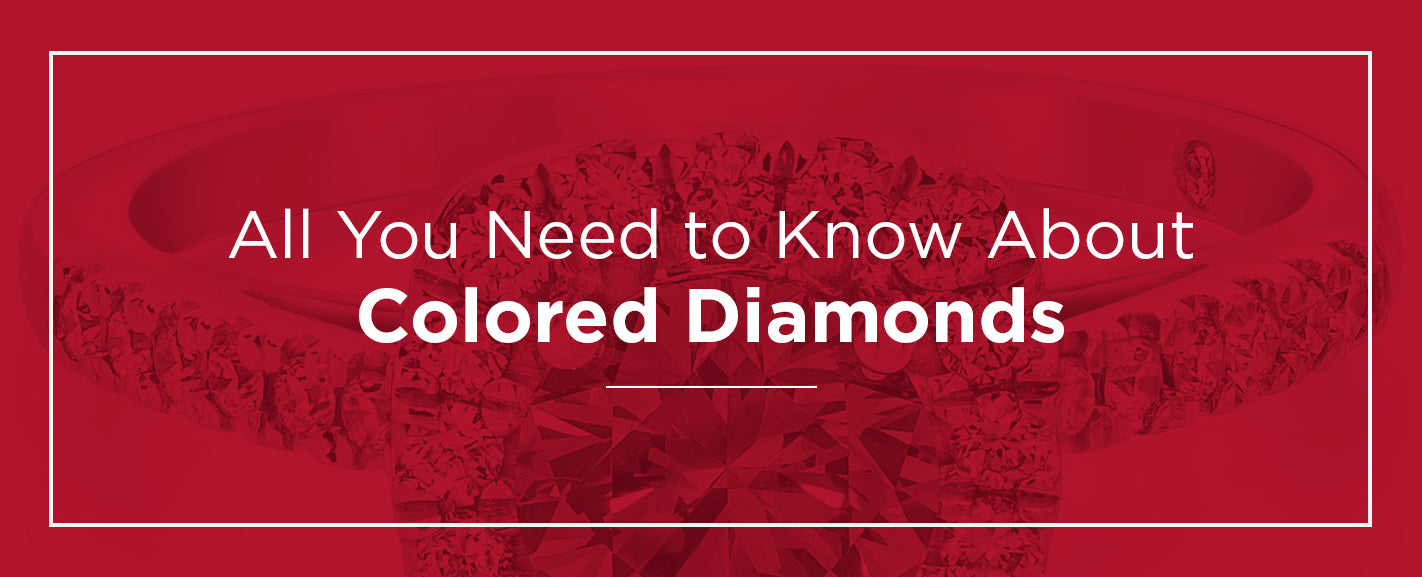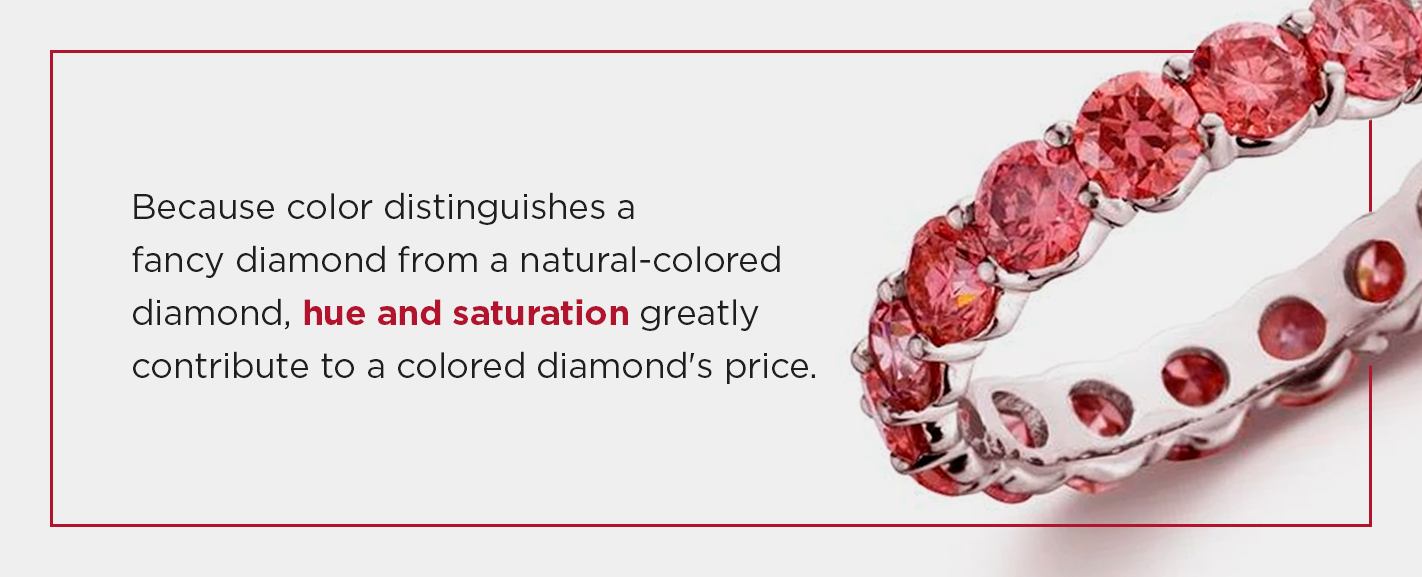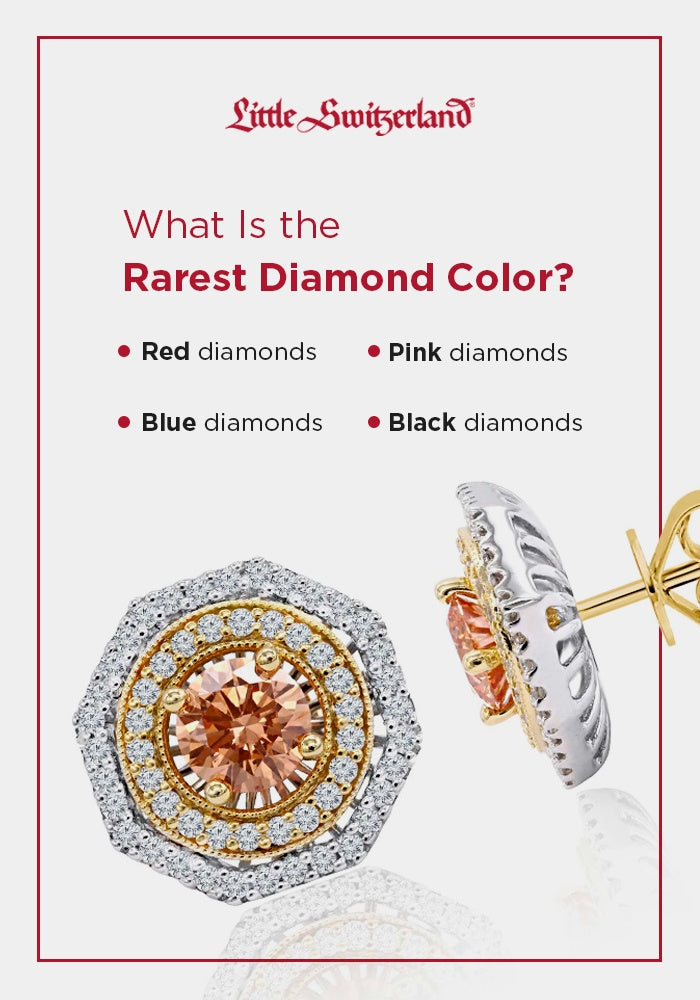All You Need to Know About Colored Diamonds

Traditional diamonds bear sentimental meaning. As a longstanding symbol of enduring love and commitment, diamonds adorn engagement rings, wedding rings, necklaces and more. For many, a classic diamond is one of the most meaningful gifts. But traditional diamonds aren't the only type you may have seen at your local jewelry store.
Colored diamonds offer a twist on the classic gem. With a blend of sentimentality and the bold colors typically found in other gemstones, colored diamonds make stunning, unique jewelry pieces. Because they are less common, it's natural for colored diamonds to spark questions. Whether you're curious about the gemstones or looking to purchase, this guide will tell you everything you need to know about colored diamonds.
What Is the Natural Color of Diamonds?
When you picture a diamond, you likely imagine a sparkling, colorless gem. That's because a majority of mined and lab-grown diamonds form in a colorless state. Scientists use a variety of terms to describe natural-colored diamonds such as "colorless," "white," and "clear." Regardless of what it's called, a natural-colored diamond gains its appearance from the way it forms.
In the Earth, diamonds form under intense heat and pressure — 1,652 to 2,372 degrees Fahrenheit and 50,000 times the atmospheric pressure of Earth's surface. These conditions cause carbon atoms to crystallize together to form a solid gem. A diamond's sparkle and hardness are a result of this carbon atom structure. The better a diamond's carbon crystal structure, the more colorless, pure and perfect it will be.
After their formation and journey to the surface, diamonds are mined, inspected and cut to make the timeless gemstones we're used to seeing. If mined diamonds form in a naturally colorless state, you may wonder if colored diamonds are even real.
Are Colored Diamonds Real?
Colored diamonds are absolutely real. In fact, they appear in every hue of the rainbow. From stunning reds to eccentric greens, colored diamonds display striking hues while maintaining the durability and sparkly fire native to a diamond.
When a diamond takes on a color outside its natural range, gemologists classify it as a fancy-colored diamond. Each fancy-colored diamond varies in intensity, with some having only pale traces of color and others having intense, bright colors.
Though colored diamonds are rare and sought-after, they actually gain their color when the diamond-forming process goes awry.
What Are Colored Diamonds?
Colored diamonds are the product of an atypical formation process. They begin with similar conditions to a natural-colored diamond: intense pressure and heat. As carbon atoms crystallize, one defining factor changes the diamond's trajectory — an impurity.
When a forming diamond is exposed to specific particles, they can alter the diamond to display beautiful colors. The type and amount of an impurity a diamond interacts with determines its color properties. Jewelers and gemologists have developed a special system to rate the color properties for each fancy diamond.
The classification system is based on three categories:
- Hue: A fancy diamond's hue refers to the color category you see when the diamond is face-up. This includes primary and secondary colors, as well as mixtures like reddish-orange or greenish-blue. The Gemological Institute of America (GIA) rates the hue on a scale from "faint" to "fancy deep."
- Tone: A colored diamond's tone refers to its lightness or darkness. A gem with a light tone will appear pale, whereas a gem with a dark tone will show a dark hue that looks like it's mixed with black. The GIA uses a scale from "extremely light" to "medium to dark" to rate colored diamond tone.
- Saturation: The saturation or intensity of a colored diamond indicates its strength and purity. Low saturation tends to appear brownish or grayish, and high saturation indicates nearly pure color. The GIA rates saturation on a scale from "low" to "moderate to high."
Because color distinguishes a fancy diamond from a natural-colored diamond, hue and saturation greatly contribute to a colored diamond's price. Generally, the more intense and more prevalent the color, the more expensive a colored diamond will be. Mined colored diamonds also tend to cost more due to their rarity.

How Do Diamonds Get Their Color?
Diamond coloring involves a combination of the right timing and the right elements. Diamond colors do occur in nature, but they can also occur in a lab. Lab-grown diamonds harness the power of science to recreate the diamond-formation process. Because scientists understand the impurities that produce most diamond colors, they can create stunning colored diamonds in a lab.
Whether a colored diamond was mined or lab-grown, the formation process is intricate and remarkable:
Diamond Color in the Earth
A colored diamond's journey begins nearly 100 miles below the surface of Earth's upper mantle. At this location, the weight and pressure create perfect conditions for diamond formation. As carbon atoms crystallize, diamonds emerge. But no drilling equipment can reach this far into the Earth.
In order for diamonds to reach the surface where they can be mined, a perfectly-tuned volcanic eruption must occur. These eruptions are deep-seated and violent, unlike anything we've experienced in modern times. When these eruptions reach the surface, they create a mound of magma that cools and encases the diamonds in a vertical pipe.
These pipes and mounds are known as "Kimberlites," and are named after the South African town of Kimberely that first discovered the structures. Based on scientist's knowledge of the diamond and Kimberlite formation process, they have determined several things about diamonds, like:
- Most diamonds mined today probably formed in the first couple billion years of Earth's history.
- Kimberlite rock is dated at tens of hundreds of millions of years old, which means diamonds didn't travel to Earth's surface until years after they were formed.
A natural-colored diamond forms from pure carbon with a perfect structure. A colored diamond, however, encounters some form of structural or particulate impurity that changes its color. The odds of this happening in nature are rare, so colored diamonds are often more expensive and prestigious.
According to the GIA, one out of every 10,000 carats of fashioned diamonds displays fancy colors. Of those mined fancy colored diamonds, only one out of every 25,000 displays an intense color saturation. Given the scarcity and astounding formation process of a colored diamond, the price tag for these fancy colored gems can be high. This is part of the reason why some colored diamonds are lab-grown.
Diamond Color in the Lab
Lab-grown diamonds have emerged in recent years as a conflict-free and technologically-advanced way to produce stunning gems. In this scenario, scientists simulate the conditions necessary to create diamonds in a controlled environment to create synthetic diamonds.
This process offers several benefits for colored diamonds, including:
- Greater control: Because scientists guide the diamond formation process, they can strategically introduce the right elements to create a colored diamond. This offers greater control over the hue, tone and saturation of a specific gem.
- Decreased price: Lab-grown colored diamonds don't have the same kind of scarcity as their mined counterparts. This allows individuals with a greater range of budgets to appreciate and enjoy the beauty of a colored diamond.

In order to offer colored diamonds to a greater market, scientists have developed two formation methods. The first is known as Chemical Vapor Deposition, or CVD.
Chemical Vapor Deposition Method
CVD begins when a scientist puts a thin slice of diamond seed into a heating chamber. The heating chamber then creates a plasma ball of heated gases, which provides the amount of heat necessary to help the diamond grow.
With the right conditions set, scientists increase the heat in the chamber to encourage diamond growth. This continues for a few weeks as the diamond grows one atom at a time. While the diamond grows, scientists add gases like nitrogen to give diamonds a desired color.
After the diamonds have finished growing, scientists remove them from the heating chamber and send them to gemologists to be cut into the gem shapes we know and love. Though the CVD method creates colored diamonds from a diamond seed, some lab coloration methods work with existing stones.
High-Pressure/High-Temperature Method
The High-Pressure/High-Temperature, or HPHT, method was first developed to treat natural-colored diamonds that had impurities. Today, HPHT can be used to alter or enhance an existing diamond's color. As the name suggests, scientists use high pressure and high temperatures to simulate the diamond formation conditions.
Colored HPHT diamonds typically begin as brown-colored diamonds. The HPHT treatment can transform the brown color into yellow, greenish-yellow, green, pink, blue and orange-yellow. HPHT creates permanent, vibrant colors that will not fade.
What Are the Different Diamond Colors?
When nature and science create atypical diamonds, what colors can you expect? Almost every color of the rainbow is represented among fancy colored diamonds. Some colors can only be mined in specific locations. Other colors emerge under little-understood circumstances. Whatever the case, each diamond color requires conditions as unique as its beauty.
Red
Red diamonds occur when a diamond is exposed to traces of boron and nitrogen. These gems often appear with orangey or purplish tones, but the rarest red diamonds emulate the deep, rich color of a ruby. According to the Capetown Diamond Museum, only 20-30 deep red mined diamonds exist. This dark red can only be found in Africa, Australia and Brazil.
There are several famous red diamonds, including:
- The Rob Red: A pear-shaped .59-carat fancy red diamond with the most saturated and purest red color in the world.
- The Moussaieff Red Diamond: A 5.11-carat trilliant-cut red diamond discovered by a Brazilian farmer. It is currently the largest red diamond in the world.
Pink
Pink diamonds occur in greater abundance than their red counterparts. Their color forms due to a distortion in the diamond crystal lattice that causes the stone to absorb green light. This distortion gives the diamond a pink color that can range from light and faint to vivid.
Orange
Orange diamonds occur when specific nitrogen atoms group together. This structure causes the diamond to absorb both blue and yellow light, which gives it an orange appearance. Some orange diamonds resemble a faint, pastel orange, some feature a vibrant orange and some lean toward an orange-brown hue.
Yellow
Like orange diamonds, yellow diamonds occur when nitrogen atoms form specific bonds. These bonds only absorb blue light, which gives the yellow diamond its color. Yellow diamonds can either display cooler colors that sway toward yellow-green or warmer colors that sway toward yellow-orange. Regardless, yellow diamonds range from icy, pale yellow to a bright, lemonade yellow.
Green
Green diamonds gain their hue when they are exposed to radiation that disrupts the typical carbon structure. These types of diamonds are extremely rare in nature and range from electric green to a muted olive. The most famous green diamond is 41-carat gem known as the Dresden Green. It was discovered in 1988 and is the largest and finest-quality gem of its kind.
Blue
Blue diamonds occur when a diamond is exposed to boron that makes the carbon structures bond. This bond causes the diamond to absorb red, yellow and green light to present a blue appearance. Blue diamonds range in color from a light, icy blue to deep blue, depending on the amount of boron they were exposed to. These gemstones are typically found in India and South Africa.
The most famous blue diamond is known as the Hope Diamond, which currently resides at the Smithsonian Institute.
Purple
Purple diamonds form when extra hydrogen becomes trapped in the crystal lattice. Most purple diamonds occur in shades of purplish-red or purplish-blue. Pure purple-colored diamonds are extremely rare from mines.
Gray
Gray diamonds exhibit a more smoky color than natural-colored diamonds. A hydrogen defect causes these gems to absorb equal quantities of all light wavelengths, which gives the stone a gray color. Some fancy gray diamonds have a more pronounced color that comes from exposure to boron.
Brown
Scientists aren't certain what causes brown diamonds, but many propose that internal parallel grain lines give the gem its color. Brown diamonds range in color from light brown to a darker, chocolate brown. When compared to other colored diamonds, brown diamonds occur in relative abundance.
Black
Black diamonds form from graphite inclusions and random clustering. These diamonds differ from other colored diamonds because they do not display the sparkly fire many are used to. Mines in Brazil and Central America are some of the few locations with black diamonds.
Some of the most famous black diamonds include:
- The Black Orlov: A cushion-cut brooch with a 67.5-carat black diamond in the center.
- The Spirit of Grisogono: A 312.24-carat black diamond framed in a diamond-studded necklace.
What Is the Rarest Diamond Color?
Colored diamonds that have been mined are all considered rare, but some colors are especially elusive and valuable. Some of the rarest mined diamond colors include:
- Red diamonds
- Blue diamonds
- Black diamonds
- Pink diamonds

Within these rare diamond categories, a diamond's saturation and tone can make it even rarer. Regardless of hue, a colored diamond is a unique and gorgeous addition to any piece of jewelry.
Shop Colored Diamonds and More at Little Switzerland
Whether you're looking for colorless or colored diamonds, Little Switzerland has a selection of stunning luxury diamond jewelry for any occasion. As the most trusted jeweler in the Caribbean for more than 60 years, we offer world-class luxury and jewelry brands.
Shop diamonds set in white, yellow or rose gold in a variety of cuts and colors to find a piece you love. Find the perfect diamond earrings, pendant necklaces, bangles or ring when you visit our stores or shop online. For an elegant, unforgettable piece, shop our selection of diamond jewelry today.



